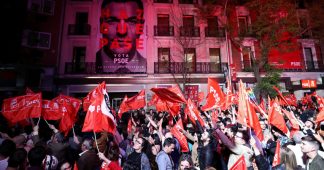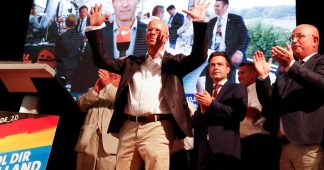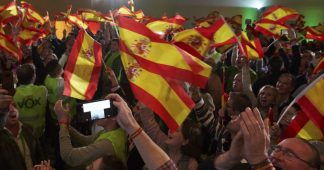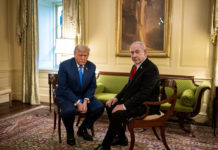On Wednesday, the Netherlands held Europe’s first national election since the start of the pandemic — and the entire center-left took just 20 percent of the vote. While the crisis provided a chance to call for radical economic change, the “post-ideological” center-left posed no alternative to the government’s call to return to normal.
By Kevyn Levie
Mar.20, 2021
“At its core, the Netherlands is a center-right country,” says incumbent prime minister Mark Rutte. It’s March 17, election night, and Rutte’s hard-right People’s Party for Freedom and Democracy (VVD) has just won its fourth election in a row. In the first national elections in Europe since the start of the pandemic, both the governing center-right coalition and the populist far right consolidated their positions. The Dutch center-left, in decline for over a decade, received only one-fifth of the total vote.
Rutte is right, at least when it comes to these elections: the country by and large voted in support of his center-right government and there were net gains for the four coalition parties, who together took 79 out of 150 seats, up from the 2017 contest. Besides Rutte’s VVD, at 35 seats, coalition partner D66 — a liberal center-right party — also profited from being in government, taking 24 seats. Their government’s collapse over a racist anti-benefit fraud policy scandal two months ago seems not to have bothered their voters in the least. The result means that VVD and D66 will likely form the core of the next coalition government, with one or two other centrist or left-wing parties.
While there is no minimum threshold for election to the national parliament, this contest brought a level of fragmentation unique even by Dutch standards. A record number of seventeen parties, five newcomers among them, will enter the 150-seat lower house at the end of March. This also means that the dwindling support for the progressive wing of Dutch politics is now spread out over five minor (center-)left parties, jointly amassing just 32 seats: SP (socialist), GroenLinks (green left), PvdA (social democratic), PvdD (Party for the Animals), and the radical-left newcomer BIJ1 (“together”).
But perhaps the huge defeat for these parties — their combined support has almost halved in the last decade from 59 seats in 2012, to 42 in 2017, to 32 today — perhaps shouldn’t have been such a surprise to pollsters and analysts on Wednesday night. After all, the election campaign in general lacked any true antagonism or sense of urgency. All parties, especially the three traditional left parties (SP, GroenLinks, PvdA), seemed more obsessed than ever with convincing voters that they were ready to join a right-wing government. For the first time, even the socialist SP — whose breakthrough in the 1990s owed to voter dissatisfaction with how the social democrats had given up their principles in coalition governments — didn’t rule out a pact with Rutte’s right-wing VVD.
No Alternative
More particularly, the left-wing parties’ campaigns each lacked an ideological, visionary alternative to the way the right-wing government handled the COVID-19 crisis and its economic consequences over the past year. In 2020, there was huge momentum for change: the pandemic could have been taken as an opportunity to transition to a different kind of economy, tackle the climate crisis, and allow for a better work-life balance for all. And the large Black Lives Matter protests last summer could have sparked a broad debate on fighting racism and other forms of inequality.
Instead, the momentum passed: “returning to normal life” as soon as possible became all parties’ central focus — and the idea of aspiring to something better than society as it was before vanished from public debate. The Left largely supported the way the government handled the COVID-19 crisis, without any noteworthy fundamental criticism. In fact, the pandemic was hardly a topic during this election campaign at all. Instead, TV election debates were dominated by worn-out discussions on topics like immigration, and an extraordinary amount of attention was devoted to whether parties were able to compromise and conform to a post-ideological concept of “leadership.”
The Dutch left thus seems to have learned strikingly little from the last large crisis: the financial and economic crisis that swept the world from 2008 onward. Then, too, the Dutch left-wing parties were unable to use the crisis as momentum for change and rally voters behind — or, for that matter, conceive of — a viable alternative to the prevailing economic order. This resulted in a big victory for the right-wing VVD and extreme-right PVV in 2010. Two years later, the social democratic Labour Party (PvdA) readily joined forces with the Right to impose unprecedented austerity on the country, arguing this was true leadership and “taking responsibility.”
Partly because of the lack of ideological debate, and partly due to the pandemic making a regular offline campaign impossible, the mainstream media’s influence on Wednesday’s election results was bigger than ever. Research shows that the governing parties, and especially Prime Minister Rutte, got a disproportionate amount of media attention compared to the Left. The big win for social-liberal D66 has much to do with its overwhelmingly positive coverage by analysts and on talk shows. And the new forces deemed promising by white middle-class journalists — the pan-European liberal Volt party and JA21, now the third right-populist party in parliament — gained several seats more than they might have done otherwise.
BIJ1, the only left-wing newcomer in these elections, did not have such an advantage. Indeed, it got hardly any media coverage at all: the one seat they gained is solely thanks to them steadily making headway in activist circles and among voters in the largest cities. The fact that their leader, Sylvana Simons, will now enter parliament is an achievement in terms of representation, if nothing else: in the previous parliament, there was not a single black MP. She has promised to be a thorn in the side of the rest of the Left, and is likely to spark debate on topics like racism where other left-wing politicians fail to.
However, it remains to be seen if the new party’s cadre is seasoned enough to fulfill the role of vanguard party they like to project. While BIJ1’s electoral platform reads like an anti-capitalist Christmas list, a substantial part of the party’s three thousand members is more liberal-leaning. And even if the party is able to steadily develop its base and ideas, for the foreseeable future it seems likely to remain a marginal force in an ever rightward-shifting political landscape.
Right Turn
Like elsewhere in Europe, mainstream political discourse in the Netherlands has been shifting to the right for at least twenty, if not forty, years — and these elections mean a new leap to the right in two ways. Firstly, in the decimation of the Left and the growth of the center-right. Secondly, while parties across the spectrum have incorporated aspects of right-populist ideology, hoping that this will appease voters, the populist right itself has only continued to gain electoral support. The new parliament will have three populist or extreme right-wing parties that together hold 28 seats — almost as much as the entire center-left. The most dangerous of these three is perhaps Thierry Baudet’s relatively new Forum for Democracy, whose representatives deny the threat COVID-19 poses, flirt with the alt-right, and hardly even try to hide their fundamentally racist and antisemitic opinions.
The new coalition government, which will almost certainly have a core bloc based on VVD and D66, will ostensibly distance themselves from the populist right while upholding an extremely restrictive refugee policy and not addressing the racism that is rampant in government institutions. They will drape themselves in a progressive aura, with attention to climate change and a somewhat anti-cyclical economic policy, at least so long as the pandemic lasts. But their plans for budget cuts as soon as the pandemic ends have already been written, as have plans for substantial labor market reforms cutting back workers’ rights.
Meanwhile, the Dutch left will have a chance — perhaps its last chance — to regroup. First of all, that must mean refusing to join a center-right coalition government. For the Socialist Party, an ideological reorientation and new leadership is long overdue. For the Greens and Labour, it might mean merging into a new party. But most importantly, all need to finally develop radical, convincing alternatives to the hegemonic center-right dogmas, and to build movements that for once have a realistic chance of winning the next elections in 2025.
In the past, the Netherlands has been a country where certain political developments seemed to unfold earlier and more violently than elsewhere in continental Europe. In the 1990s, Dutch Labour embraced the Third Way early and unambivalently. At the start of this century, the Netherlands was, together with Austria, one of the first countries where right-wing populism became a large and lasting political force. And in the 2010s, Labour finance minister Jeroen Dijsselbloem imposed harsh austerity measures not only on his own country but on Greece and other countries as well through his Eurogroup presidency.
Of course, a collapse of the Left is also already well underway in countries like France and Italy — but it is to be hoped that Wednesday’s disaster does not tell left-wing parties across the rest of Europe what they should expect from their first post-pandemic elections. That means it is now up to the Left elsewhere in Europe — most notably the German left in the run-up to the Bundestag elections in September — to rally voters behind a radical alternative to the status quo and show the Left doesn’t have to lose elections in times of crisis











